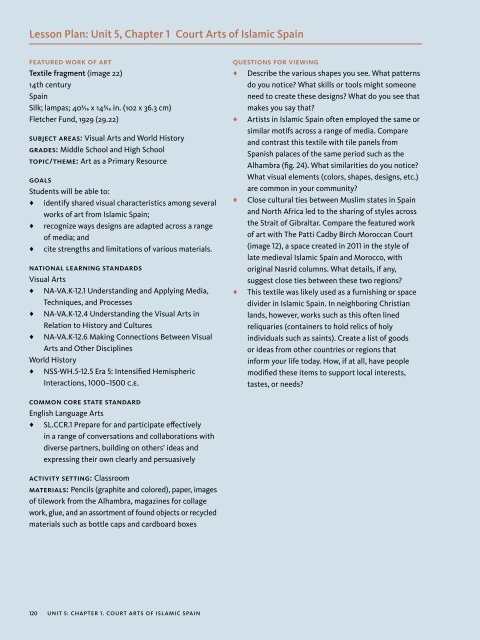Courtly Splendor in the Islamic World - The Metropolitan Museum of ...
Courtly Splendor in the Islamic World - The Metropolitan Museum of ...
Courtly Splendor in the Islamic World - The Metropolitan Museum of ...
You also want an ePaper? Increase the reach of your titles
YUMPU automatically turns print PDFs into web optimized ePapers that Google loves.
Lesson Plan: Unit 5, Chapter 1 Court Arts <strong>of</strong> <strong>Islamic</strong> Spa<strong>in</strong><br />
featured work <strong>of</strong> art<br />
textile fragment (image 22)<br />
14th century<br />
Spa<strong>in</strong><br />
Silk; lampas; 403⁄16 x 145⁄16 <strong>in</strong>. (102 x 36.3 cm)<br />
Fletcher Fund, 1929 (29.22)<br />
subject areas: Visual Arts and <strong>World</strong> History<br />
grades: Middle School and High School<br />
topic/<strong>the</strong>me: Art as a Primary Resource<br />
goals<br />
Students will be able to:<br />
♦♦ identify shared visual characteristics among several<br />
works <strong>of</strong> art from <strong>Islamic</strong> Spa<strong>in</strong>;<br />
♦♦ recognize ways designs are adapted across a range<br />
<strong>of</strong> media; and<br />
♦♦ cite strengths and limitations <strong>of</strong> various materials.<br />
national learn<strong>in</strong>g standards<br />
Visual Arts<br />
♦♦ NA-VA.K-12.1 Understand<strong>in</strong>g and Apply<strong>in</strong>g Media,<br />
Techniques, and Processes<br />
♦♦ NA-VA.K-12.4 Understand<strong>in</strong>g <strong>the</strong> Visual Arts <strong>in</strong><br />
Relation to History and Cultures<br />
♦♦ NA-VA.K-12.6 Mak<strong>in</strong>g Connections Between Visual<br />
Arts and O<strong>the</strong>r Discipl<strong>in</strong>es<br />
<strong>World</strong> History<br />
♦♦ NSS-WH.5-12.5 Era 5: Intensified Hemispheric<br />
Interactions, 1000–1500 c.e.<br />
common core state standard<br />
English Language Arts<br />
♦♦ SL.CCR.1 Prepare for and participate effectively<br />
<strong>in</strong> a range <strong>of</strong> conversations and collaborations with<br />
diverse partners, build<strong>in</strong>g on o<strong>the</strong>rs’ ideas and<br />
express<strong>in</strong>g <strong>the</strong>ir own clearly and persuasively<br />
actiVity sett<strong>in</strong>g: Classroom<br />
materials: Pencils (graphite and colored), paper, images<br />
<strong>of</strong> tilework from <strong>the</strong> Alhambra, magaz<strong>in</strong>es for collage<br />
work, glue, and an assortment <strong>of</strong> found objects or recycled<br />
materials such as bottle caps and cardboard boxes<br />
120<br />
UnIt 5: ChAPter 1. CoUrt ArtS <strong>of</strong> ISLAmIC SPAIn<br />
Questions for View<strong>in</strong>g<br />
♦♦ Describe <strong>the</strong> various shapes you see. What patterns<br />
do you notice? What skills or tools might someone<br />
need to create <strong>the</strong>se designs? What do you see that<br />
makes you say that?<br />
♦♦ Artists <strong>in</strong> <strong>Islamic</strong> Spa<strong>in</strong> <strong>of</strong>ten employed <strong>the</strong> same or<br />
similar motifs across a range <strong>of</strong> media. Compare<br />
and contrast this textile with tile panels from<br />
Spanish palaces <strong>of</strong> <strong>the</strong> same period such as <strong>the</strong><br />
Alhambra (fig. 24). What similarities do you notice?<br />
What visual elements (colors, shapes, designs, etc.)<br />
are common <strong>in</strong> your community?<br />
♦♦ Close cultural ties between Muslim states <strong>in</strong> Spa<strong>in</strong><br />
and North Africa led to <strong>the</strong> shar<strong>in</strong>g <strong>of</strong> styles across<br />
<strong>the</strong> Strait <strong>of</strong> Gibraltar. Compare <strong>the</strong> featured work<br />
<strong>of</strong> art with <strong>The</strong> Patti Cadby Birch Moroccan Court<br />
(image 12), a space created <strong>in</strong> 2011 <strong>in</strong> <strong>the</strong> style <strong>of</strong><br />
late medieval <strong>Islamic</strong> Spa<strong>in</strong> and Morocco, with<br />
orig<strong>in</strong>al Nasrid columns. What details, if any,<br />
suggest close ties between <strong>the</strong>se two regions?<br />
♦♦ This textile was likely used as a furnish<strong>in</strong>g or space<br />
divider <strong>in</strong> <strong>Islamic</strong> Spa<strong>in</strong>. In neighbor<strong>in</strong>g Christian<br />
lands, however, works such as this <strong>of</strong>ten l<strong>in</strong>ed<br />
reliquaries (conta<strong>in</strong>ers to hold relics <strong>of</strong> holy<br />
<strong>in</strong>dividuals such as sa<strong>in</strong>ts). Create a list <strong>of</strong> goods<br />
or ideas from o<strong>the</strong>r countries or regions that<br />
<strong>in</strong>form your life today. How, if at all, have people<br />
modified <strong>the</strong>se items to support local <strong>in</strong>terests,<br />
tastes, or needs?

















